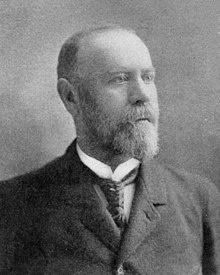Walter L. Weaver
Walter Lowrie Weaver | |
|---|---|
 | |
| Member of the U.S. House of Representatives from Ohio's 7th district | |
| In office March 4, 1897 – March 3, 1901 | |
| Preceded by | George W. Wilson |
| Succeeded by | Thomas B. Kyle |
| Personal details | |
| Born | April 1, 1851 Montgomery County, Ohio |
| Died | May 26, 1909 (aged 58) Springfield, Ohio |
| Resting place | Ferncliff Cemetery |
| Political party | Republican |
| Alma mater | Monroe Academy Wittenberg College |
Walter Lowrie Weaver (April 1, 1851 – May 26, 1909) was a U.S. Representative from Ohio.
Born in Montgomery County, Ohio, Weaver attended the public schools and Monroe Academy, and was graduated from Wittenberg College, Springfield, Ohio, in 1870. He studied law and was admitted to the bar in 1872 and commenced practice in Springfield, Ohio. Weaver was elected prosecuting attorney of Clark County in 1874, 1880, 1882, and 1885.
Weaver was elected as a Republican to the Fifty-fifth and Fifty-sixth Congresses (March 4, 1897 – March 3, 1901). He served as chairman of the Committee on Elections No. 2 (Fifty-sixth Congress). He was an unsuccessful candidate for renomination in 1900. After leaving Congress, he was appointed associate justice Choctaw-Chickasaw citizens' court at McAlester, Oklahoma, in 1902. He returned to Springfield, Ohio, in 1904 and resumed the practice of law. He died in Springfield, Ohio, May 26, 1909 and was buried in Ferncliff Cemetery.
Sources
- United States Congress. "Walter L. Weaver (id: W000229)". Biographical Directory of the United States Congress.
- 1851 births
- 1909 deaths
- Members of the United States House of Representatives from Ohio
- People from Montgomery County, Ohio
- People from Springfield, Ohio
- Wittenberg University alumni
- Ohio Republicans
- County district attorneys in Ohio
- Republican Party members of the United States House of Representatives
- 19th-century American politicians

